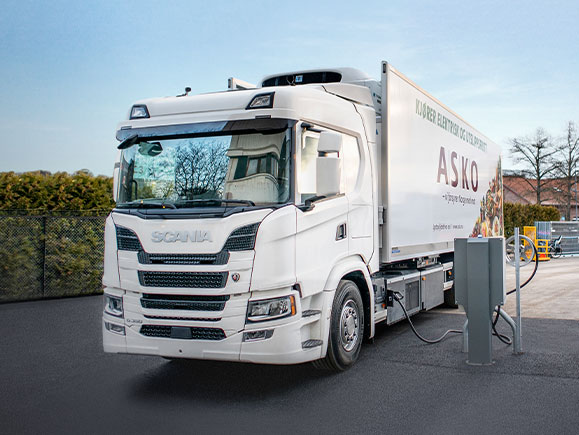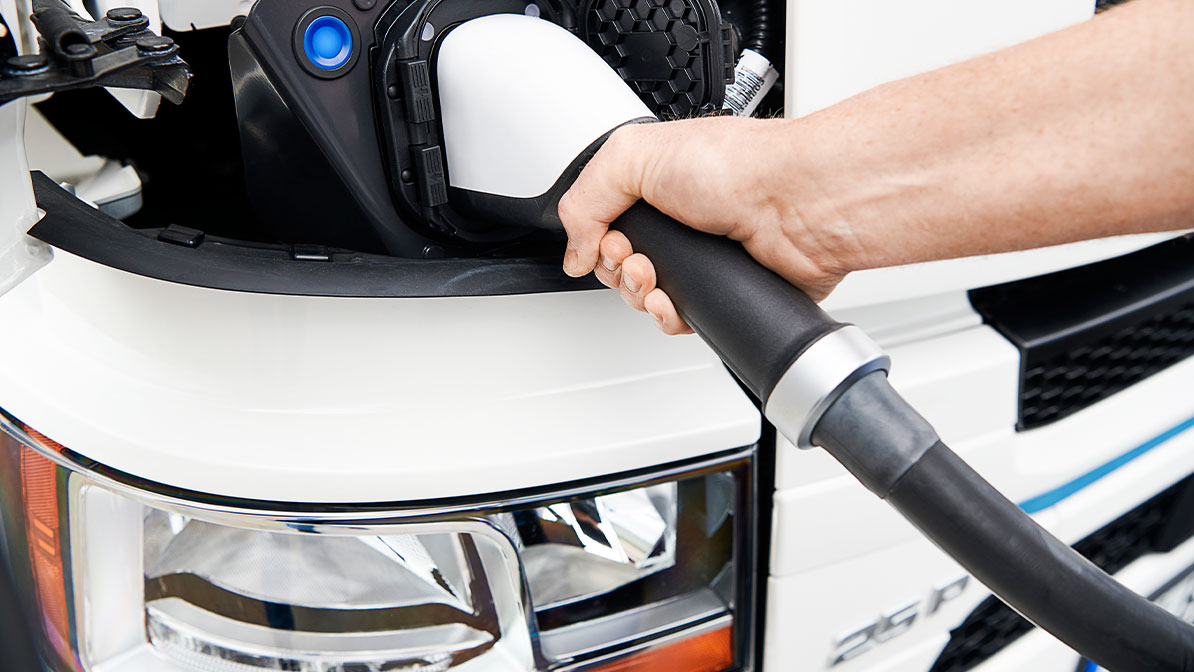Norway generates almost one hundred percent of its electricity using climate-friendly hydropower. Thanks to the exceptionally high availability of green energy, the country is an ideal testing ground for zero-emission transportation. Scania is therefore teaming up with food wholesaler ASKO to test the use of battery-powered delivery vehicles in Oslo. The first medium-duty trucks are already on the road.
It’s 6 a.m. in Oslo at the distribution center of Norwegian food wholesaler ASKO. Outside in the freezing cold, several logistics specialists are loading the last boxes of fresh fruit and vegetables into a dozen or so delivery trucks so that the goods can be delivered to grocery stores on time. Most of the medium-duty trucks are ready to depart, and the first ones are just leaving the center, which is located in the east of the city. But not all of the vehicles make the typical humming noise of a diesel engine. A battery-powered Scania 25P BEV only emits a low whir as it moves from its charging station toward an air-conditioned trailer. Before heading off, the driver connects the air conditioning unit of his trailer to the battery of his truck, and then he too leaves the distribution center to head downtown — followed by a second, almost silent Scania truck.

ASKO aims to run its entire fleet without fossil fuels by 2026, focusing primarily on battery electric vehicles.
Battery supplies electric motor and cooling unit
As a food wholesaler, ASKO offers a full range of products. “We supply our customers with all kinds of food and beverages,” says Marius Råstad, Corporate Logistics Manager at ASKO. “Our products range from coffee and bread to fresh meat, milk, and vegetables and all the way to ice-cream and frozen pizza.” This means that the cargo area of the delivery vehicles has to be fully air-conditioned — regardless of whether it’s a conventional diesel truck, a hybrid vehicle, or a completely battery-powered model such as the two Scania 25P BEV trucks. The air-conditioned trailers thus need a constant supply of electricity — which is then no longer available for the drive system in a battery-powered truck.
Ensuring that the vehicles have the required range was not the only challenge facing Scania’s engineers. “It also turned out to be tricky to supply the electric motor and the refrigerator unit with power from the vehicle battery at the same time,” reports John Lauvstad, Director Communication, Sustainability and Branding at Scania Norway. The reason: while the motor is powered by 650 V direct current (DC), the cooling unit requires 400 V alternating current (AC). To adapt the vehicles to this customer requirement, the experts at Scania used a special inverter to transform DC voltage into AC voltage.

John Lauvstad looks back on a long-standing partnership between Scania and ASKO.
“It also turned out to be tricky to supply the electric motor and the refrigerator unit with power from the vehicle battery at the same time.”John Lauvstad
Director Communication, Sustainability and Branding at Scania Norway
75ASKO plans to expand its fleet by 75 battery electric Scania trucks by 2023.
Opportunity for zero-emission deliveries
Unlike most other countries that still generate most of their electricity from fossil energy sources, Norway uses almost one hundred percent renewable hydroelectric power. This is due to the Scandinavian nation’s special topography, with high mountain ranges in the northwest and sweeping plateaus to the southeast, where runoff water collects in long fjords. With this exceptionally high proportion of sustainably generated energy, Norway is an ideal testing ground for zero-emission transportation. After all, a climate-friendly mobility cycle depends not just on appropriate vehicles, but also on the high availability of green electricity. In line with ASKO’s strategy, the company is taking advantage of this potential and turning to battery-electric vehicles in a bid to make its transport solutions even more sustainable.
The Scania 25P BEV model is an important building block here. So far, ASKO intends to order 75 electric Scania distribution trucks to be delivered by 2023. Since their delivery in the fall of 2020, the wholesaler has been using its first two electric vehicles on exactly the same routes as all other trucks running on conventional diesel power. The company is thus gaining valuable experience that is very useful for its ongoing transition. “Our dispatchers have learned a lot about the performance of the batteries during the approximately 2,500 hours that the two vehicles have been in operation so far,” Marius Råstad explains. “They know exactly which charge level the vehicles need to be able to complete a route, and they dispatch them accordingly.”

The medium-duty battery electric Scania truck is available with a capacity of 165 kWh or 300 kWh.
The drivers also play an important role in the successful operation of the trucks. Over time, they have learned to trust the electric vehicles and use their full potential in terms of range. “In the beginning, our drivers would return to the distribution center with a larger safety buffer than today,” recalls Marius Råstad. “They’re much bolder now. In conjunction with the dispatchers’ smart scheduling, a single battery charge of 165 kilowatt hours is generally sufficient to power the truck for an entire shift.“ Usually, the vehicles are then fully recharged overnight. Thanks to a 50-kilowatt quick-charge station at the depot, however, they can also be recharged between route departures or during the driver’s lunch break.
Increasing deployment times
As a next step, ASKO intends to significantly increase not only the number of climate-friendly commercial vehicles but also their operating hours. So far, they are already in use for 16 hours a day, six days a week. “At the moment, we’re still using the electric trucks in a two-shift system,” says Råstad, “but we’d like to use them around the clock in the future — where this fits in with our general schedule and transportation volume.” This is hardly surprising, given that the strengths of electric trucks can be fully leveraged in urban delivery operations. Their quiet, zero-emission motors are ideally suited for use in busy city centers and residential areas — a growing number of which are being designated as low-emission zones. In order to be able to use these advantages with more and more battery-powered trucks, ASKO will continue to expand the charging infrastructure at its distribution centers together with external partners.

Marius Råstad, Corporate Logistics Manager at ASKO, is convinced of the potential of battery electric trucks.
“In conjunction with the dispatchers’ smart scheduling, a single battery charge of 165 kilowatt hours is generally sufficient to power the truck for an entire shift.”Marius Råstad
Corporate Logistics Manager at ASKO
ASKO
Sustainability is a central component of the corporate strategy for Norwegian food wholesaler ASKO. The owner-run business with around 3,300 employees has long relied on climate-friendly drive systems for its truck fleet and uses its own wind and solar installations to produce sustainable electricity that also powers the company’s growing number of electric trucks. ASKO received the 2020 Business Climate Award from the environmental foundation ZERO, the Norwegian University of Science and Technology, and the Confederation of Norwegian Enterprise (NHO) for its commitment to sustainability. But that’s not all: to become even more sustainable in the future, the food wholesaler intends to use only energy from sustainable sources by 2026 while simultaneously reducing its energy consumption by 20 percent.
Ambitious sustainability targets
The 75 new electric vehicles that ASKO will be using by 2023 are just the beginning. Come 2026, the wholesaler aims to run its entire fleet of around 700 vehicles without fossil fuels and, with a few exceptions, use mainly battery-powered electric drive systems for this purpose. “Scania has delivered ever more sustainable vehicles with climate-friendly drive systems over the past 20 years, from biodiesel and biogas engines to hybrid drive systems,” shares Råstad. “But the latest generation of battery-powered drive systems is now opening up a whole new world of possibilities for zero-emission transportation. Next-generation batteries, improved range, and available charging infrastructure will enable us to use the electric trucks on even longer distribution routes.” And electric trucks are also becoming more attractive in terms of their cost-effectiveness, thanks to growing battery power and range combined with falling prices.



.jpg/jcr:content/Teaser-Grafik-Tiva-Sharifi-3840x2560-V1-(1).jpg
)
.jpg/jcr:content/Teaser-Grafik-Mansoureh-3840x2560-V1-(1).jpg
)


